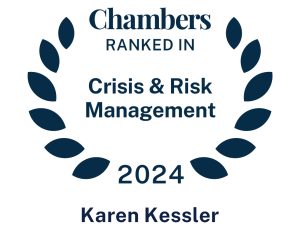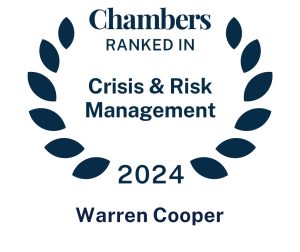We’ve all seen it.
In a moment of annoyance or frustration or just a simple lapse of judgment, a colleague, direct report, or C-suite executive tosses off a social media zinger. Intended to be funny, perhaps, it’s a little snarky but otherwise innocuous… or so it seemed. But now it’s gaining traction and attention for all the wrong reasons. The post is on its way to becoming a reputational nightmare for the colleague who posted it, leadership, and the organization itself.
To limit reputational damage and demonstrate accountability, the organization needs to take a deliberate, measured approach, regardless of whether the offending item was posted on a known employee’s personal social media account or on an organization’s platform.
1. Delete the post (if appropriate) as soon as possible. The longer it’s up and available, the greater the likelihood it will be shared and attract further criticism. (Pro tip: Take a screen shot – in case the situation leads to an internal investigation or litigation).
2. Conduct a quick, down-and-dirty internal inquiry. Try to determine how and why the post was published, how widely it was shared and viewed, who might have been affected and whether posting the content violated company policy. Was the post the result of individual misconduct, lack of oversight, or systemic failure? Put into action a plan to address the situation internally — with additional staff training, perhaps, or by terminating or putting the employee on leave, etc.
3. If a public apology is deemed necessary, issue one promptly. The apology should be professional, sincere and contrite (we’ve written about this before). It should directly engage with the audience deemed to have been affected, acknowledge the post’s inappropriateness and avoid excuses or “explanations” and should identify measures being taken to avoid it happening again. The apology should be posted on the same platform as the offending post. If the post received media attention or widespread condemnation by public officials or other prominent individuals, the response and apology can also be shared more widely: on the company’s website, LinkedIn and other social media platforms, for example. Consider, too, apologizing directly to community leaders in the space targeted by the original post.
4. Follow through on actions you set forth in your apology. For example, if you write…
“Yesterday, (our company) shared an inappropriate and deeply offensive social media post. We recognize the harm it caused and sincerely regret the failure of oversight. We take full responsibility for this misstep and are reviewing our policies and procedures and will augment them where weak to avoid this from happening again. We apologize to everyone affected.”
…make sure you conduct the promised reviews and seek input from colleagues and staff on changes to be implemented. Often, other employees and internal stakeholders come forward (to reporters, for example) to argue that really nothing was done. That can quickly become a reputational crisis itself. And when you follow up with internal stakeholders about changes, be specific: “Going forward we have implemented scheduled policy reviews, instituted multi-tiered approvals and enhanced protocols for social media communications.”
5. Don’t dodge the media or other legitimate inquiries. Any inappropriate social media post that makes the company look bad can become fodder for negative media coverage. Media outlets love to report on bad behavior by religious leaders for the simple reason that people love to read about prominent individuals and companies acting contrary to their elevated self-image or their stated commitment to good work. You won’t be able to dodge unattractive media coverage by ignoring that outreach, it just means the coverage won’t include “your side” of the story. The same is true for respond to inquiries with “no comment.” As we’ve written elsewhere, the general public hears someone say “no comment,” and thinks: They’re guilty.
6. When appropriate, respond directly and quickly to online criticism and negative feedback. You can’t manage your public reputation if you’re not monitoring comments, messages and other forms of communication from stakeholders and outsiders alike. As with media inquiries, if you ignore your critics, they don’t go away. Instead, you miss an opportunity to share your narrative and protect your brand. It can be helpful to reach out (via a Direct Message, perhaps) to someone who posts their own negative experience and try to take the conversation off-line by inviting the critic to connect with you directly. What you DON’T want to do is start responding to every troll and social justice warrior – that will just keep a negative conversation at the top of your feed. . If it becomes obvious that the critic only wants to bash you relentlessly regardless of what you say, it’s time to stop trying to defend the original post and just block the individual.
7. Immediately begin seeking opportunities to rebuild trust. This doesn’t only mean with those directly impacted by the original post, you must also work to regain the trust of those who support the post’s target. Sometimes this will mean leaning into the issue directly, by posting content that reflects the values of accountability, inclusivity or whatever lies opposite the offensive content. Sometimes it means engaging with community or stakeholder initiatives to demonstrate a tangle commitment to the social justice goals the original post maligned. Depending on what your organization “does,” it may also mean returning to sharing content that supports your core function. If you’re running a restaurant, post photos of food, or your customers enjoying a meal (with their permission, of course.) If you’re the owner of a gym, post photos of people working out (again, with their permission). If you’re operating a cruise line, post photos of people relaxing on the deck.
Finally, consider seeking the guidance of professionals, legal, public relations or otherwise.
If the post seems defaming, discriminatory or threatening, involve legal counsel to assess exposure and determine a path forward to prepare the company for a potential lawsuit. But don’t confuse legal risk with reputational risk. Attorneys focus on winning a lawsuit and can do so in ways that don’t necessarily enhance your company’s reputation.
Public relations firms, particularly firms like Kessler PR Group, that specialize in crisis communications, help protect your reputation and rebuild your company’s brand. We craft messaging, manage media inquiries and other stakeholder communications, and guide recovery. When you offload those concerns to the professionals, you can focus completely on your company’s core mission.










